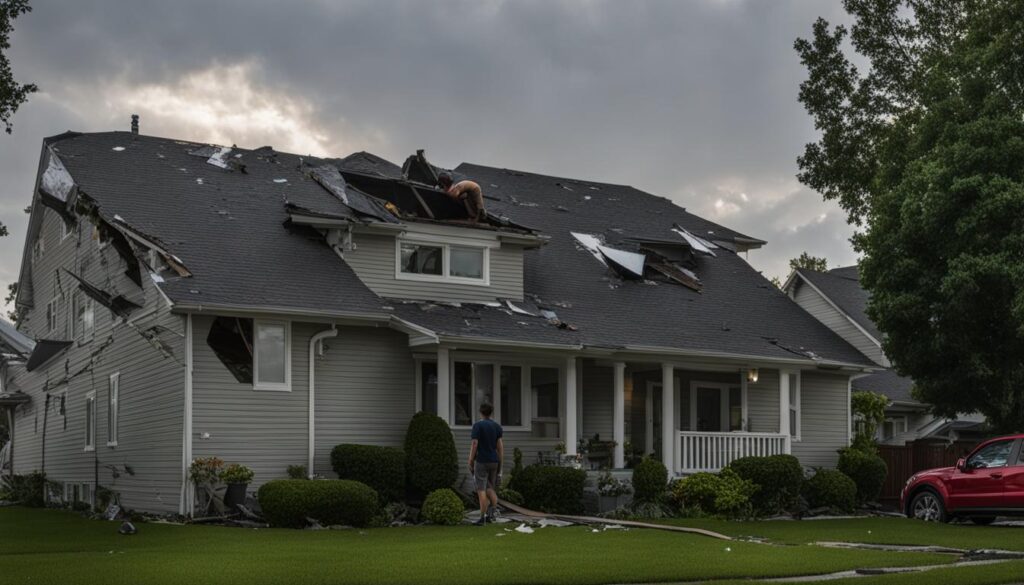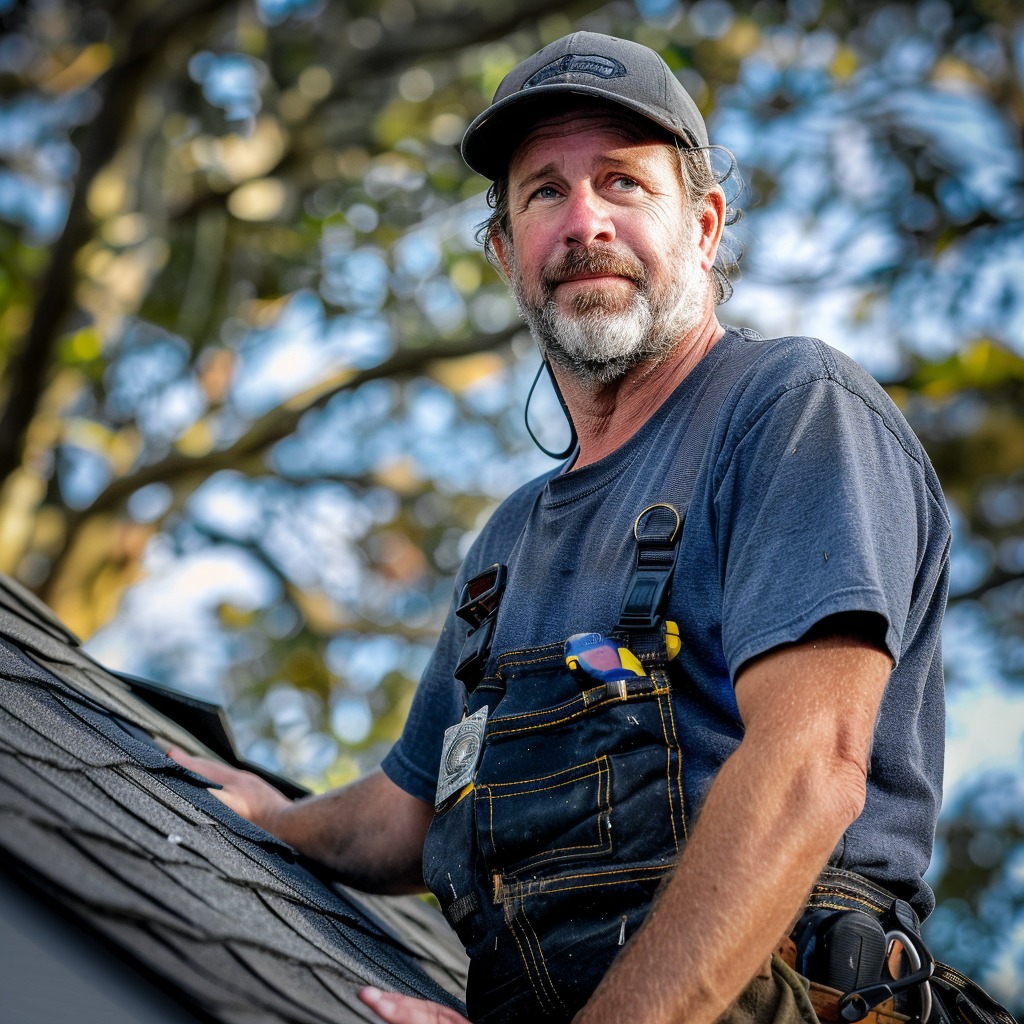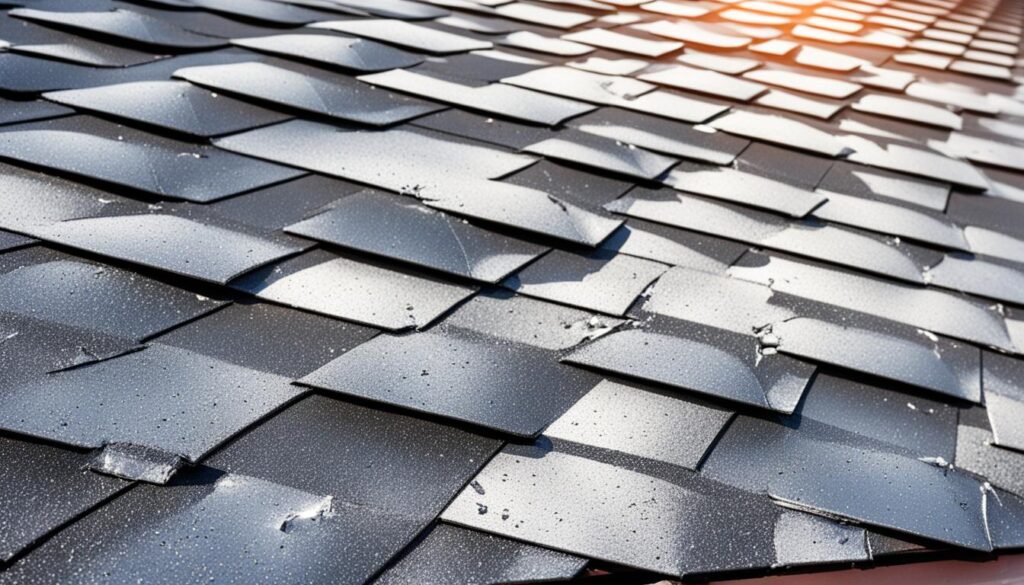Imagine waking up one morning to find your roof pockmarked with dents and your shingles looking worse for wear. Was it the result of a severe hailstorm? And if so, how can you be sure?
Hail damage on roofs can be a cause of concern for homeowners, but identifying the signs can be tricky. Is it just wear and tear? Or is it a clear indication of hail damage?
In this article, we will delve into the world of hail damage on roofs and learn how to spot the signs easily. From dents and dings to loss of granules and impact marks, we will explore the visual cues that can help you differentiate hail damage from other types of damage.
- Learn to recognize the signs of hail damage on a roof.
- Understand the characteristics of hail damage that set it apart from other types of damage.
- Explore visual cues and inspections to identify hail damage without climbing onto the roof.
- Discover the factors that affect the extent of hail damage on roofs.
- Gain insights into the insurance claim process for hail damage.
Factors Affecting Hail Damage on Roofs
The amount and type of hail damage to a roof can be influenced by several factors. Understanding these factors can help homeowners assess the potential extent of hail damage to their roofs and take appropriate measures for protection and repair.
Wind Impact on Hail Damage
During a hailstorm, the wind direction and speed can impact the severity of the damage to a roof. Strong winds can drive hailstones with greater force, causing more significant damage to the roofing materials. Additionally, winds can change the trajectory of the hailstones, leading to varied points of impact on the roof’s surface.
Size and Density of Hailstones
The size and density of hailstones also play a crucial role in determining the level of damage. Larger and denser hailstones can inflict more substantial damage to the roofing materials upon impact. It is important to note that different hailstorms can produce a wide range of hailstone sizes, from small pea-sized hail to larger grapefruit-sized hail.
Building Materials and Hail Damage
The type of building materials used for the roof can affect the degree of hail damage. Some materials, such as asphalt shingles, can withstand hail better than others. Metal roofs, for example, are more resistant to hail damage due to their durability and strength. Understanding the resilience of different roofing materials can help homeowners make informed decisions when choosing or repairing their roofs.
Barriers Reducing Hail Damage
Various barriers can help reduce the impact of hail on roofs. Neighboring structures, such as taller buildings, can provide some shielding from hailstones, reducing the direct impact on the roof. Additionally, tree cover or landscaping near the property can act as natural barriers, absorbing some of the hail’s force. These barriers can mitigate the severity of hail damage to some extent.
By considering these factors, homeowners can better assess the potential impact of hailstorms on their roofs and take proactive measures to minimize damage. Regular inspections, using resilient roofing materials, and implementing protective barriers can help safeguard roofs against hail damage.
Identifying Hail Damage from the Ground
Homeowners can easily identify hail damage from the ground without the need to climb onto the roof. By looking for visible signs, they can assess the potential damage and take the necessary steps for further assessment and repair. These signs serve as indicators of hail damage and can guide homeowners in contacting their insurance company for appropriate action.
Visible Signs of Hail Damage
Here are some visible signs of hail damage that can be observed from the ground:
- Dents and dings on siding and window sills: Hailstones can create noticeable dents or dings on the exterior surfaces of a home. Inspecting the siding and window sills for these signs can help identify hail damage.
- Damage to decks and porches: Hail can cause significant damage to outdoor structures like decks and porches. Look for cracks, splits, or splintered wood as potential signs of hail damage.
- Dents in gutters and downspouts: Check the gutters and downspouts for dents or indentations caused by hail impact. These can indicate the presence of hail damage on the roof.
- Holes in window screens: Hail can create holes or tears in window screens. If you notice any, it may be a sign of hail damage.
- Damage to outdoor air conditioning units: Inspect the outdoor air conditioning unit for any visible signs of damage. Hail impact can cause dents or other forms of damage to these units.

These visible signs can be helpful in determining the presence of hail damage without the need to physically access the roof. However, it is important to note that while these signs may indicate hail damage, a professional roof inspection may still be necessary to assess the extent of the damage and determine the appropriate repairs or replacements needed.
Tips for the Insurance Claim Process
When it comes to filing an insurance claim for hail damage, homeowners need to navigate the process carefully to ensure a smooth and successful outcome. Here are some essential tips to keep in mind:
- Understand the insurance process: The insurance claim process can be confusing and overwhelming. Familiarize yourself with the steps involved, including documentation requirements, deadlines, and the role of insurance adjusters.
- Avoid roofing contractor scams: After hail damage, it’s common for roofing contractors to approach homeowners offering repairs. Be cautious and do your research before hiring anyone. Verify their credentials, check online reviews, and get multiple quotes to avoid falling victim to scams.
- Don’t sign any paperwork until the insurance claim is approved: Some roofing contractors may pressure you to sign contracts or agreements before your insurance claim is approved. Avoid signing any paperwork until you have received confirmation from your insurance company.
- Be aware of mistakes by insurance adjusters: While insurance adjusters are trained professionals, they can make mistakes in assessing hail damage. If you believe the initial assessment is incorrect or inadequate, don’t hesitate to request a reevaluation or a second opinion from another professional.
By following these tips, homeowners can protect themselves from potential pitfalls and ensure a fair and efficient insurance claim process for hail damage.

Conclusion
Recognizing and addressing hail damage on a roof is crucial for homeowners. By understanding the signs of hail damage, the factors that affect it, and the insurance claim process, homeowners can take proactive steps to prevent or address hail damage effectively.
One of the key preventive measures is regular roof maintenance. Homeowners should conduct regular inspections to identify any potential issues and address them promptly. By keeping the roof in good condition, they can minimize the risk of hail damage and extend its lifespan.
Having appropriate insurance coverage is equally important. In the event of hail damage, homeowners need the financial protection to cover the cost of repairs or roof replacement. Ensuring adequate coverage can provide peace of mind and prevent financial burdens in the aftermath of a hailstorm.
By taking proactive steps for roof maintenance, such as inspecting for hail damage and ensuring adequate insurance coverage, homeowners can protect their investment and maintain the integrity of their roofs. This proactive approach not only helps to avoid costly repairs but also ensures the safety and comfort of their homes for years to come.

Meet William Adams, a seasoned roofing expert with over 30 years of hands-on experience in the industry. Having worked tirelessly under the scorching sun and through the fiercest storms, William brings a wealth of knowledge and expertise to the table. Hailing from the heart of the USA, he’s witnessed the evolution of roofing practices firsthand, mastering every aspect along the way. Now retired from the field, William spends his days cherishing time with his loved ones while sharing his invaluable insights through this platform. With William at the helm, you can trust that every tip, advice, and recommendation provided is backed by years of real-world experience and unwavering dedication to quality craftsmanship. Join us as we journey through the world of roofing, guided by the wisdom and passion of a true industry veteran.

